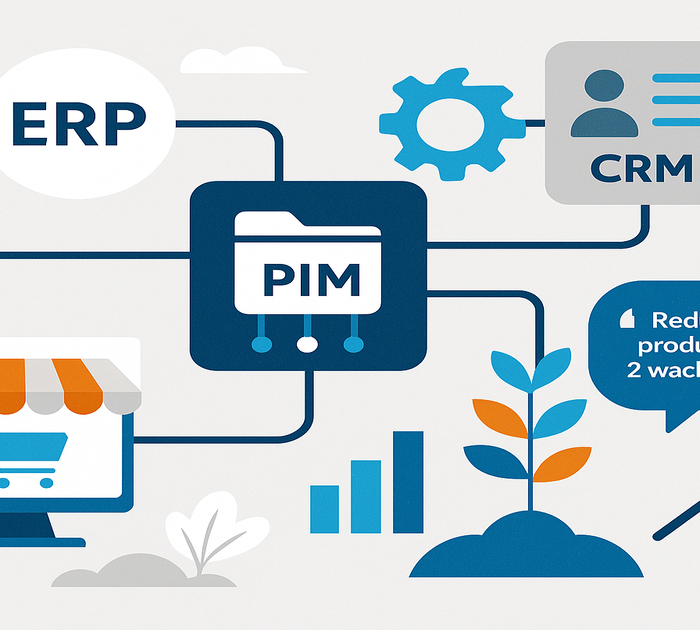If your team still wrangles product data in spreadsheets and scattered drives, you’re not alone. Most manufacturers start there because it’s fast and familiar. However, as SKUs, variants, regions, and channels multiply, the cracks show: duplicated specs, mismatched units, outdated images, and listings rejected by marketplaces. This is exactly where Perfion PIM (Product Information Management) fits. It centralizes product truth—attributes, assets, locales, and channel rules—so marketing can publish accurate, compelling content everywhere, without copy-paste chaos.
What a PIM is (and what Perfion adds)
At its core, a PIM is the system that holds what you say about a product: names, features, dimensions, compliance notes, images, videos, 3-D files, and translations. Perfion goes further by giving you a flexible data model, strong validation, and channel-ready templates. Consequently, you maintain facts once and syndicate them to your web store, distributor portals, Amazon, GS1, catalogs, and sales tools in a few clicks.
Key concepts—explained simply
Attributes
These are the building blocks of product truth—length, material, color, certifications, bullet points, SEO title, and so on. In Perfion, attributes are structured and validated. Because values follow rules (required fields, unit standards, value lists), junk data can’t sneak in.
Products and Variants
A product might have dozens of options—colors, sizes, voltages. Perfion handles this with inheritance: shared facts live once at the parent level, while only the differences belong to each variant. As a result, updating “polycarbonate housing” happens one time, not 40.
Locales and Localization
Selling globally means language and regulation changes. Perfion layers locales (e.g., en-US, es-MX, de-DE) with fallback rules so incomplete translations never block launches. Meanwhile, you can localize units, claims, and compliance wording per market.
Digital Assets
Attach images, 3-D, and PDFs directly to the product. Perfion creates the right renditions automatically (hero, zoom, thumbnail, print). It also manages rights and expiry dates, so the wrong photo doesn’t slip into a campaign.
Channel Templates
Amazon wants one set of fields; your dealer portal wants another. Perfion maps your master data to each target with templates and pre-publish validation. Therefore, fewer listings bounce back for missing or malformed attributes.
How Perfion differs from your other systems
Spreadsheet → flexible but fragile. No roles, no version history, and endless “final_v9” files. Perfion replaces this with governance, workflows, and controlled updates.
ERP → owns operational truth (item codes, costs, inventory). Perfion owns marketing and customer-facing truth (descriptions, images, channel mapping). Integrating both prevents double entry and pricing/spec mismatches.
DAM → stores assets well, but doesn’t understand products or attributes. Perfion links assets to each SKU, enforces usage rules, and publishes the correct renditions per channel—no babysitting exports.
Why manufacturers adopt Perfion PIM
Faster launches
Because attributes and assets are complete and validated up front, you publish to priority channels in days, not weeks. Previews catch issues before go-live, not after.
Fewer errors and returns
Standardized units, controlled lists, and accurate images reduce wrong-part orders and “no-fault-found” RMAs. Additionally, Perfion’s audit trail shows who changed what, and when.
Lean marketing ops
Instead of chasing files, your team enriches content, tests headlines, and improves conversion. Workflow nudges the right person at the right time—engineering for specs, legal for claims, marketing for copy.
Scale without chaos
New brand? New region? New marketplace? Add a template, localize what differs, and reuse the rest. The model grows with you, not against you.
A practical way to start—this quarter
Pick one product family and two channels.
Define your “attribute BOM.” Decide owners, units, and naming rules.
Load clean data and the must-have assets into Perfion.
Enable previews and validation. Fix issues in one place.
Publish, measure, and iterate. Track time-to-publish and listing error rate; expand once stable.
Within a few sprints, you’ll feel the difference: fewer fire drills, faster approvals, and cleaner listings.
Bottom line
Perfion PIM turns scattered product information into a governed, reliable engine for growth. Because it connects attributes, assets, locales, and channels, your launches move faster, your partners get what they need, and your customers see accurate, persuasive pages—every time. If you want help standing it up with ERP and e-commerce, Fonseca Advisers can guide the blueprint, integration, and training.
Perfion manages customer-facing product truth—attributes, images, translations, and channel rules—with validation and workflows. ERP keeps operational data; spreadsheets can’t enforce accuracy at scale.
Perfion centralizes content, validates required fields, and uses channel templates with previews. Therefore, teams fix issues once and syndicate everywhere, cutting time-to-publish dramatically.
Yes. Perfion integrates via APIs and connectors. Typically, ERP owns item codes and costs; Perfion owns descriptions and assets; e-commerce consumes the finished, channel-ready content.






